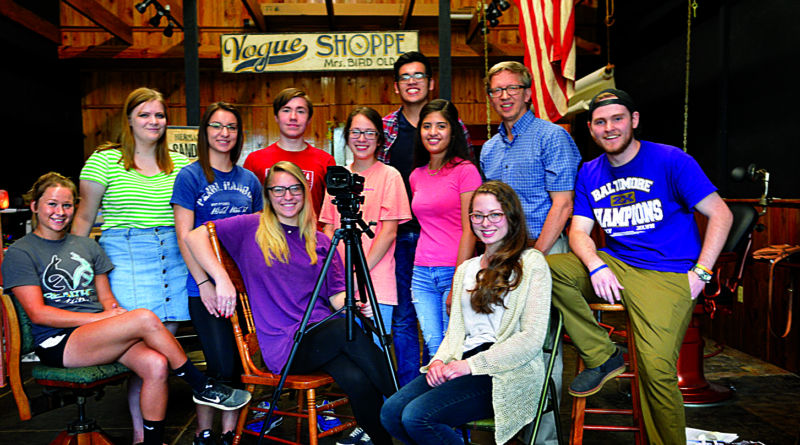Sex and capitalism, politics and religion on tap for February film debut at college

Smoldering Wick: The Story of Mary Kay debuts at 7 p.m. February 16 at NTCC’s Whatley Center. Led by Dr. Andrew Yox,
Northeast Honors the researchers, script writers, cast and crew are: Madison Blood, Karsen Nelson, Adriana Rodriguez,
Rachel Jordan, Jordan Whelchel, Brenda Godoy, Sebastian Martinez, Leivy Zuniga, Cassidy Watkins, R. Andrew Yox and
Matthew Chambers. Not pictured are Rhylie Anderson, Alicia Cantrell, Yaritza Romero and producer Warren Wu.
Sex and capitalism, politics and religion on tap for February debut at college (7 pm. Feb 16)
Before Mary Kay the Texas-born cosmetic queen, they found Mary Kathlyn Wagner, the 1934 Senior Class Orator at Houston’s Reagan High.
“Mary Key represents one of the most remarkable re-definitions of American capitalism and culture in the late-twentieth Century,” said Dr. Andrew Yox, a professor leading annual safaris following historic trails turning on the outcome of Texas tales.
One year in Daingerfield his expedition found Morris Shepard, Father of Prohibition, author of the 18th amendment in 1920 beginning 13 years banning the sale of alcohol in America.
Northeast history professor Dr. Andrew Yox’s innovative teaching style unravels stories with study of Texas forces shaping events influencing America on a national stage.
Without Daingerfield Congressman Morris Shepherd there’d have been no outlaw stories of Titus County moonshine, no rise to Chicago Mobs brewing Speak Easy beer as the underworld foundation of organized crime.
No black and white James Cagney gangster movies.
The Mary Kay journey begins because an out-of work woman discovered a lotion used by a Collin County skinner tanning hides. Coincidentally, the lotion he massaged into hides he tanned kept his hands young and supple.
Fortunes turn on a dime, or in this case, $500 Mary Kathlyn paid the skinner’s daughter for the formula.
Wiping the lipstick off Mary Kay, the Honors Northeast scholars under Dr. Yox’s direction came up with the life of a divorcee selling home cleaning products to support three children before becoming an American icon with a secret life rippling beneath a pink corporate veil.
“She’s in favor of ruthlessly sexualizing every woman in America,” whispered a grapevine turning to conspiracy with passage of the 1970’s Equal Rights Amendment (ERA) on the line.
Passed by congress and the senate, in 1972 the ERA was submitted to the states for ratification. With 35 of 38 required states approving and Texas hanging in the balance as a battleground, the constitution seemed destined to be amended until Phyllis Schafly mobilized conservative women in opposition.
Walking into a set up masked as an afternoon tea on the upscale side of Houston, Mary Kay strolled in to be ambushed by Betty Friedan, a writer an activist whose book “The Feminine Mystique” some say ignited the 1960’s wave of American feminism in the 20th century.
“We’ll either force some financial support for the ERA down Mary Kay’s throat or humiliate her,” said the woman cast in this account as a Houston socialite, a rival going back to high school days.
Her soaring ride into fame and money took flight of its own, a ride gone wild running places she had no intent to be.
“You come away from the story with a new appreciation of how Southern and Texan regional culture has filtered modern trends,” said Professor Yox.
Armed with laptops, recorders, cameras and lights, the Honors Northeast troops turned their study of yesterday’s news into a script, “Smoldering Wick, The Story of Mary Kay,” the fifth documentary film written and produced at Northeast Texas Community College.
Underwritten by a college grant and the support of Jerald and Mary Lou Mowery, they traveled to Dallas, Denton and Fort Worth last summer researching her life. They filmed Metroplex scenes of their one-hour show at historical sites including the Azalea Plantation House, Miss Molly’s Hotel, the Rosen House and the Texas White House.
Mary Kay might rightly have gone either way on women’s rights. As the top performing sales recruiter and third ranked salesman in the home cleaning products business, she’d banged into the glass ceiling of the 1950’s solid man corporate world. Walking off from that one, she’d worked years rising as a top performer for a similarly-modeled company.
In that act, the decision makers pass her over in favor of one of her male recruits and justify the call because she made no bones about telling the company’s commissioned sales force that career was third in line behind God and family.
The Mary Kay cosmetic story gets traction as a free-enterprise combine the day a Parkland Hospital lab chemist got Federal Drug Administration (FDA) approval for use of the tanner’s lotion formula as a cosmetic.
Marketed as a balm with the powers of a fountain of youth, sales of Mary Kay’s Timewise Skin Care Set generated a coast-to-coast American tide of “consultants” channeling rivers of cash to a queen of capitalism.
When the consultants recruit new consultants, they become directors.
Rather than hiring sales managers, Mary Kay grew them.
Her second marriage was to George Hallenbach, the chemist walking Mary Kay’s new line through the FDA. He gave up his lab career to manage the company cash flow, then died before it was paying the bills.
First year sales fell just short of $200,000. The second year topped a million. At the top it morphed into a family business as she brought her children aboard. Ten years in with each year’s sales setting records, the children watching the books more than their mother have visions of Mary Kay’s becoming America’s first self made woman billionaire.
History has an underbelly.
Honors students turned to script writers made themselves actors, cast themselves as church hypocrites reluctant to question the motives and methods of a business woman whose riches poured through he Southern Baptist Convention.
Scene 47, First Pastor: “Here we have a preeminent Southern Baptist running the largest cosmetics firm in America. Doesn’t that pose problems from the standpoint of Isaiah 3, and the prophet’s concern with the gaudy, sexual attire of women?”
Second Paster: “I’m afraid to go there. She might pick up and leave. And her contributions could end up in the pockets of some interdenominational phony who thinks he needs a Rolls Royce to make house calls.”
The Big Brains of Honors Northeast know how to start a fight, disposing of her high school heart-throb first marriage with an opening punch to the heart as she lights the dinner table with a candle following his return from World War II. Ten years after high school, he’s an aspiring singer.
Him: “Put that stupid candle out!”
Her: (Dutifully sweeping the candle from the table as she considers this part of a larger conversation before turning on him) : “So you help beat the Germans by driving a truck and now you’ve earned the right to leave your wife and children?”
Him: “You were the one who thought we needed children. Quit being such a parasite!”
Her: (Angry) “You’re the one talking like a reptile.”
Him: “You’ve wrecked my singing career, leaving me alone with the children while you play at frumpy business woman – and now you think I’m the reptile?”
She stares him down.
Him: “Okay, okay,” (tone of false reconciliation), “I’ll be a lizard, for your sake. I’ve been making love to another woman. I love her.”
Once divorced, once widowed, Mary Kay’s third marriage ran counter to the Corporate Mary Kay image, blew over embers of gossip flaming to life as judgment.
“Mel Ash smokes, he drinks and raves about the swimsuit edition of Sports Illustrated,” daughter Marylyn complained.
“The guy’s got eyes like a wolf,” agreed Ben, the oldest son, children blind to the romance of a man remembering every week’s Thursday anniversary of the day they met for 13 years.
Then he died.
The children grew concerned about their mother’s weight – another image thing for the company committed to making and preserving the youthful beauty of women.
Her spending more time organizing conventions to recognize the success of consultants rather than managing the deepening stream of cash flow left them at a loss.
The “Mary Kay Way” advocated the right of women to put family over business in a company putting recognition of success and personal ties above economic incentive.
Some see her spiritualization of business as a sem-idolatrous confusion of faith and capitalism.
She never publicly answered her critics.
In Scene 55, 1983, she meets secretly with Phyllis Schlafly and quietly contributes to the conservative activist in Dallas mustering Texas opposition to the ERA.
The ERA never passed.
Mary Kay died in 2001.
Debuting at 7 p.m. Feb. 16
You can see the trailer below:





